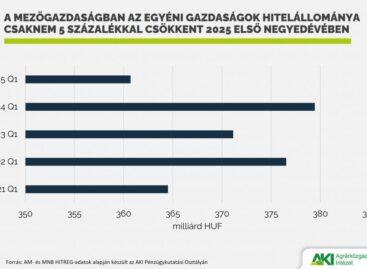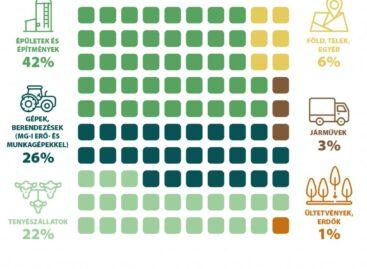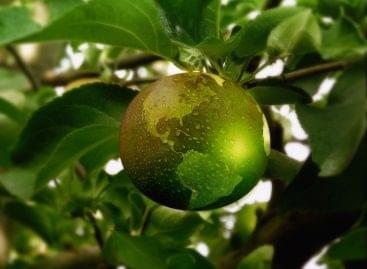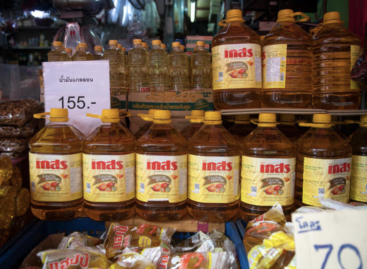The investments of the past few years in domestic horticulture have paid off
Grown peppers and tomatoes can now be found on store shelves all year round, and from mid-April the entire sector will be supplying not only the domestic but also the export markets with fresh, healthy goods. Although the pace of developments was broken by last year’s unfavorable economic environment, according to the overview of the National Chamber of Agriculture and the Hungarian Vegetable and Fruit Trade Organization (FruitVeB), the new rural development tenders can once again give impetus to the implementation of planned investments in the sector.
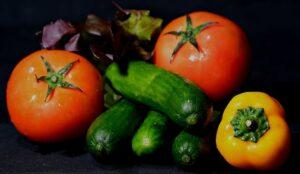
(Photo: Pixabay)
In recent years, dynamic developments have taken place in domestic greenhouse vegetable production, which were primarily aimed at increasing production efficiency and quality. According to the overview of the National Chamber of Agrarian Economy and the Hungarian Vegetable and Fruit Trade Organization (FruitVeB), thanks to the developments, in addition to supplying the domestic market, exports have also continued to expand in the individual product categories. Although the upswing that started in 2016 was interrupted in 2022-2023 by the unfavorable economic environment and the increase in the cost of financing, the new rural development tenders expected in the period ahead may give another boost to the implementation of planned investments in the sector. According to the plans, the tender entitled “Support for post-harvest developments related to horticultural greenhouses and cold storages” will be published in May 2024, which is expected to be very popular among the players in the sector. In our country, farmers grow vegetable crops on a total of 3,090 hectares, 15 percent of the surfaces are greenhouses, 30 percent are heated block foil, and 55 percent are cold-pressed foil houses.
As a result of the developments, the efficiency of production improved
Tomato production in greenhouses increased by approximately 110 hectares, so it now exceeds 310 hectares. Of the 150-160 thousand tons of tomatoes produced here, 75-80 percent are berry and cluster tomatoes, the rest are cherry and cocktail tomatoes. Domestic producers can supply the domestic market with cocktail and cherry tomatoes from April to October, and we are self-sufficient in cluster tomatoes from the beginning of April. The export opportunities of domestic companies are improved by the growing demand for grown tomatoes in the European Union, our exports now reach 14,000 tons. The fact that the import of fresh tomatoes is constantly decreasing, while the amount of exports is increasing year by year, indicates the expansion of domestic production and the increase in the level of self-sufficiency. In the first quarter, we shipped the most tomatoes to Romania, but a significant amount was also sent to the Czech Republic, Slovakia, Germany and Austria from domestic greenhouses. At the moment, mainly cluster tomatoes are exported, in the future it is expected that the export of cocktail and cherry tomatoes will also increase.
In addition to tomatoes, the past period also shows good results in the case of sprouted peppers
The production area exceeds 1,110 hectares, and the annual quantity harvested is close to 140,000 tons. Last year, the turnover of domestic TV (stuffed, white sweet) peppers increased significantly, but the demand for large, colorful and sweet peppers – California or Pritamine – is also noticeably increasing. Relatively few of the domestic nurseries grow these types, but based on consumer needs, there would be room for a change of varieties in this direction. Our country is almost completely self-sufficient in paprika, and even exports the produced amount. Since the self-sufficiency level of many neighboring and nearby countries is extremely low, most Hungarian paprika goes to Germany, Slovakia, Austria, Slovenia, and the Czech Republic.
Our cultivation of snake cucumbers is also constantly developing
In the last 10 years, it has been produced on an increasingly large surface in modern greenhouses, thanks to which the quality of the product and shelf life have improved significantly. The annual yield is 21-22 thousand tons nationally, of which the first pickings can already be found on store shelves from mid-February.
Domestically grown vegetables can be among the fresh market products where quality supply and year-round delivery to supermarket chains is possible and solved
As a result, our greenhouse production provides safe, high-quality and timely products for the domestic and international markets. Sprouted tomatoes and peppers are available in stores throughout the year, although in smaller quantities during the winter. With the approach of spring, the amount of domestic produce increases continuously, and from the middle of April, domestic peppers, tomatoes and cucumbers completely take over the place of imports in the trade. The biggest advantage of domestically grown vegetables is that they reach consumers’ tables fresh every day, since the products are already on the shelves of stores within a day of picking, compared to the 1-week delivery time of imported goods. In addition, tomatoes, peppers, cucumbers and lettuce grown in domestic greenhouses are vitamin-rich, healthy vegetables, since in 80-90 percent of domestic greenhouses, farmers use biological plant protection using natural enemies of pests. Not to mention that because of this, the ecological footprint of the locally grown product is significantly lower than that of imported goods.
NAK
Related news
Agricultural loans decreased by 6 percent
Agricultural loans decreased by 6.0 percent to HUF 1,001.2 billion…
Read more >Agriculture’s income-generating capacity may depend on irrigation
Europe is facing an increasingly significant water shortage, so agriculture’s…
Read more >42 percent of agricultural investments were spent on buildings and structures in 2024
According to preliminary data from the Central Statistical Office, the…
Read more >Related news
Corporate leaders’ commitment to sustainability at record level
According to the latest data from the K&H Sustainability Index,…
Read more >FAO food price index rose slightly in June due to higher prices of meat, dairy products and vegetable oils
The Food and Agriculture Organization of the United Nations (FAO)…
Read more >What can cause the price of a wine to increase tenfold?
There are fewer of them worldwide than the number of…
Read more >
